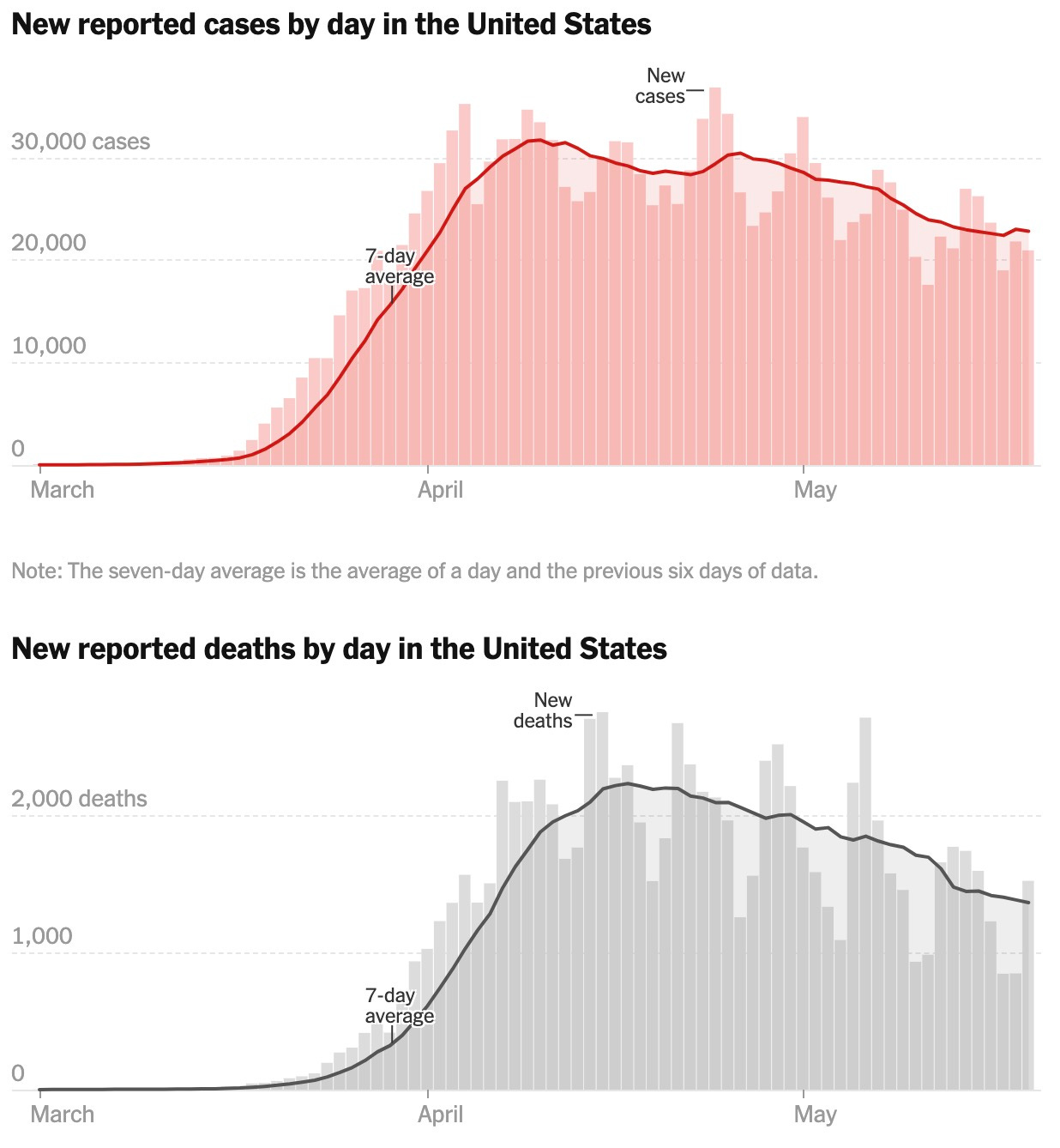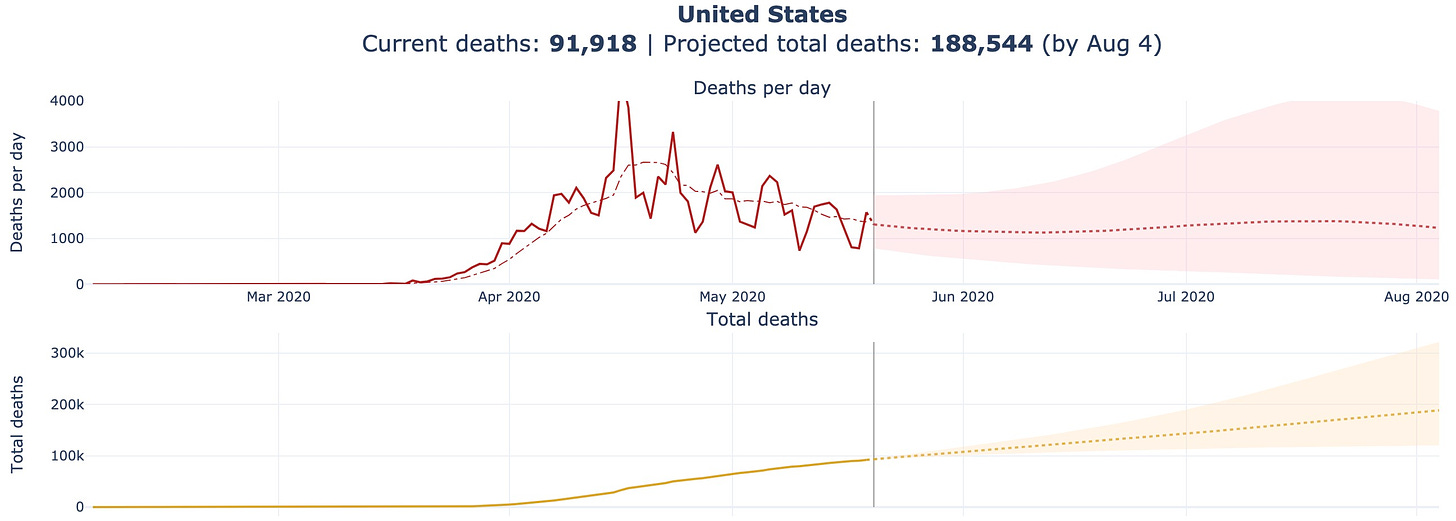For the first time in four months, there is good news.
The last 16 weeks have been so relentlessly grim that some people may have forgotten what good news looks like. But the trend on the coronavirus numbers in the United States is unambiguously good.
We can argue about how good the figures are and whether or not they’ll continue improving. But for just a second, it’s worth pausing to be grateful that the grim tide is receding.
Some perspective, courtesy of the New York Times:

The daily number of new cases is clearly declining. The daily number of new deaths is declining. This good news isn’t uniform—there are a few states where the virus is ramping up. And the data isn’t even exactly current—because of the lag time caused by the virus’s incubation period, today’s results are really just the after-image of the world as it existed two weeks ago.
But it’s still good.
Also good is that testing capacity seems to have moved off of its April plateau and begun growing again to the point where we’re now closing in on 400,000 a day.

This is still short of where most experts think we need to be—1 million tests per day seems to be the consensus goal. But this trend, too, is moving in the right direction.
Now would be a good time to thank God, to mourn our dead, and to celebrate the work and sacrifice of millions of everyday Americans who got us this far.
Because what comes next may not be very nice.
What does “winning” look like? That’s what the modelers are trying to figure out—and the answer is likely to be: People keep dying.
The coronavirus is unlikely to go away on its own, so we need to think in terms of managing it. And there are three pathways to managing an infectious disease:
Herd immunity
Vaccination
Therapeutic treatments
Herd immunity. Once a certain percentage of the population has been infected and has recovered, the spread of a disease can slow or stop, since uninfected people will mostly be surrounded by people who are not and can no longer be infectious. The threshold required to reach such “herd immunity” varies depending on the specific factors of the virus, and we don’t yet know what it is for COVID-19—presumably somewhere between 50 percent and 70 percent of the U.S. population would need to be exposed. But even that is only an educated guess.
Until we can start doing random surveillance studies, we won’t know what percentage of America has had the coronavirus, but it is unlikely to be anywhere near that range.
Also: Since we don’t know how long immunity lasts after someone has contracted this particular virus, achieving herd immunity could be harder than we’re assuming.
Vaccination. Think of vaccines as creating artificial herd immunity. They’ll be great—if and when we have one that is proven and being produced and distributed at scale. This is unlikely to happen before the medium-term future, and only then if we are very lucky.
Therapeutics. The most likely outcome for the near term is that we find ways to treat COVID-19 that dramatically lower the case fatality rate. People would still catch the bug and some percentage of them would still become symptomatic—but an effective course of therapy would stack the deck in favor of patients.
If you forced me to bet $100 on which of these three pathways will open up for us first, my money would be on the therapeutics. But it’s important to understand that at this point none of them is close to the finish line.
Which means that even as we climb down the other side of the coronavirus curve, a lot of people are going to die.
How many people? We’ve got a bunch of models to give us a sense of what the numbers might look like. (Please keep in mind the core function of models.)
Start from where we are. We don’t know the true death toll from the coronavirus—we’ll have to wait for researchers to pore over the raw death totals and figure that out at a later date—but for right now, we have over 90,000 confirmed U.S. deaths from the disease.
FiveThirtyEight has helpfully stacked a bunch of the models in one place to see what their projections look like for the next four weeks. The lower bound of the most optimistic model is 99,000 total deaths. The median estimate puts us around 125,000 dead. All of them see the total number of deaths continuing to increase for the next eight weeks.
The one I find most interesting comes from Youyang Gu, whose model “COVID Projections” is an exercise in pure data, with machine learning doing most all of the heavy lifting. Over the course of the last few months, COVID Projections has tracked very closely with reality.
So what does the COVID Projections model see going forward?

That is a long, ugly tail. The confidence interval indicates that through the end of June, at best we’ll be seeing about 300 people die from COVID every day. At worst, 3,300 a day. (The mean projection is an average that’s a little more than 1,100 a day.)
Adding up those numbers, by August 1, the model puts our official COVID death toll at anywhere from 120,000 to 320,000.
I know: That’s a big range.
I know: This is just one model.
And yes, I know: Models are not reports sent back from the future.
But the point to grok here is that just about every one of the models projects the drumbeat of daily deaths continuing all the way through the summer.
Which suggests that our new reality isn’t going to look like the world as it was in January. It’s going to be a world where people are dying from this virus every day. Where we constantly have to worry about localized outbreaks to keep the numbers even at a “manageable” level. And this manageable level is going to be so high that COVID-19 is likely to be—all on its own—the third-leading cause of death in America this year.
Imagine taking the list of ten leading causes of deaths in the United States and just adding—overnight—an entirely new one. Bigger than suicide. Bigger than traffic accidents. Bigger than Alzheimer’s. Because that’s the future we’re looking at.
With one key difference: Unlike heart disease or cancer, COVID-19 is infectious and has the capability of scaling up rapidly should we get unlucky again.
So that’s the bad news.
Right now we’re winning. But victory against COVID-19 won’t look like the world we used to know.





